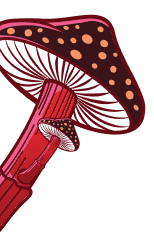
The taste of the Chaga Mushroom is a topic of interest for many people. Understanding the flavor profile and how it can be enhanced or altered through various preparation methods is essential to fully appreciate this unique fungus. In this article, we will delve into the taste of Chaga mushrooms, explore different cooking techniques, and learn how to pair them with other foods for a delightful culinary experience.
Understanding the Chaga Mushroom
Origin and Habitat of Chaga Mushrooms
Chaga mushrooms, scientifically known as Inonotus obliquus, are a fascinating type of fungus that thrives in cold regions, particularly on birch trees. These unique mushrooms can be found in areas like Siberia, Russia, and Northern Canada, where the climate is conducive to their growth. The appearance of Chaga mushrooms is distinctively woody, with a dark, charcoal-like exterior that stands out against the pale bark of the birch tree. They typically grow on the trunk of the birch tree, forming a symbiotic relationship with the host tree.
The growth of Chaga mushrooms is a slow process, taking several years for them to mature and develop their characteristic features. As they grow, they absorb nutrients and compounds from the birch tree, contributing to their rich nutritional profile and potential health benefits. Harvesting Chaga mushrooms requires careful attention to ensure sustainability and preservation of the delicate ecosystem they inhabit.
Nutritional Profile of Chaga Mushrooms
Chaga mushrooms are not only intriguing in appearance and habitat but also in their nutritional composition. These mushrooms are renowned for their impressive array of nutrients, making them a sought-after ingredient in traditional medicine and modern wellness practices. Among the key components found in Chaga mushrooms are antioxidants, which help combat oxidative stress in the body and support overall health. Additionally, Chaga mushrooms are a good source of fiber, essential minerals like potassium and manganese, and vitamins such as vitamin D and the B-complex group.
One of the most notable elements of Chaga mushrooms is their polysaccharide content, which is believed to play a significant role in boosting the immune system. Polysaccharides are complex carbohydrates that have been studied for their potential health benefits, including anti-inflammatory and immune-modulating properties. Incorporating Chaga mushrooms into dietary supplements or herbal remedies is a common practice to harness these beneficial compounds for overall well-being.
The Unique Taste of Chaga Mushrooms
Describing the Flavor Profile
The flavor profile of Chaga mushrooms is often described as earthy, woody, and slightly bitter. It has a robust and complex taste that can be likened to a combination of coffee and black tea. Some individuals also detect subtle hints of vanilla and caramel, adding a touch of sweetness to the overall flavor.
Chaga mushrooms, scientifically known as Inonotus obliquus, grow predominantly on birch trees in cold climates such as Siberia, Canada, and Alaska. The harsh environment in which they thrive contributes to their unique taste profile, as they absorb nutrients and compounds from the birch trees, resulting in a rich and distinctive flavor.
Comparisons to Other Foods
When trying to understand the taste of Chaga mushrooms, it can be helpful to compare it to other familiar foods. While it does resemble the bitterness of coffee and the earthiness of mushrooms, it stands out with its unique blend of flavors. Chaga mushrooms have a deeper and more intense taste compared to common culinary mushrooms, making them a standout ingredient in dishes.
Due to their nutrient density and potential health benefits, Chaga mushrooms have gained popularity in the wellness community. They are often used in teas, tinctures, and even incorporated into recipes for their distinct taste and potential medicinal properties. The versatility of Chaga mushrooms in culinary applications allows for creative exploration in both savory and sweet dishes, offering a unique gastronomic experience.
How Preparation Methods Affect Taste
Understanding how different preparation methods can impact the taste of Chaga mushrooms is essential for anyone looking to incorporate this unique ingredient into their diet. From raw consumption to brewing tea or cooking with Chaga, each method offers a distinct flavor profile that can cater to various preferences.
Raw Chaga Mushroom Taste
Consuming raw Chaga mushrooms is not common due to their tough and woody texture. However, if you do decide to eat them raw, be prepared for an even stronger and more concentrated earthy flavor. The bitterness may also be more pronounced when consumed in its raw form. Despite the challenging texture, some enthusiasts appreciate the raw experience for its robust and unadulterated essence, which provides a true taste of the mushroom in its purest form.
Chaga Tea and Its Flavor
One popular way to consume Chaga mushrooms is by preparing Chaga tea. When steeped in hot water, Chaga mushrooms release their flavors and create a dark, earthy beverage. Chaga tea has a milder flavor compared to raw Chaga, with a smoother and less bitter taste. The tea often has a nuanced hint of sweetness, providing a pleasant balance to the overall flavor profile. Additionally, Chaga tea is valued not only for its taste but also for its potential health benefits, as it is believed to contain various antioxidants and nutrients that can support overall well-being.
Cooking with Chaga Mushrooms
Cooking Chaga mushrooms can bring out their flavors and make them more palatable. By incorporating them into soups, stews, or sauces, the taste of Chaga blends harmoniously with other ingredients, enhancing the overall dish. The cooking process softens the texture of the mushroom, making it more enjoyable to eat. Furthermore, cooking with Chaga allows for the infusion of its earthy notes into the entire dish, creating a depth of flavor that adds a unique twist to traditional recipes.
Pairing Chaga Mushrooms with Other Foods

Complementary Flavors and Ingredients
When it comes to pairing Chaga mushrooms with other foods, it's important to consider flavors that will enhance and complement their unique taste. Rich and earthy ingredients like roasted meats, dark chocolate, nuts, and roasted vegetables can harmonize well with the flavors of Chaga mushrooms. The bitterness of Chaga can be balanced by incorporating sweeter elements such as honey or maple syrup.
Additionally, exploring the umami notes of Chaga mushrooms can lead to exciting culinary creations. Ingredients like soy sauce, miso, and Parmesan cheese can deepen the savory profile of dishes featuring Chaga. The complex flavors of aged cheeses or cured meats can also provide a delicious contrast to the earthy undertones of Chaga mushrooms.
Recipes Highlighting Chaga's Unique Taste
To fully experience the taste of Chaga mushrooms, here are a few recipes that highlight their unique flavor:
- Chaga Mushroom Coffee: Brew a rich and flavorful coffee substitute by grinding Chaga mushrooms into a powder and brewing it like regular coffee.
- Chaga Mushroom Broth: Create a hearty and nourishing broth by simmering Chaga mushrooms with vegetables, herbs, and spices.
- Chaga Mushroom Chocolate Truffles: Combine the bitterness of Chaga with the sweetness of chocolate to create indulgent truffles for a delightful treat.
Exploring the versatility of Chaga mushrooms in culinary applications can lead to a myriad of delicious dishes. From incorporating Chaga powder into smoothies and baked goods to infusing oils or vinegars with its unique flavor, the possibilities are endless. Experimenting with different cooking techniques such as roasting, sautéing, or even pickling Chaga mushrooms can unlock new depths of taste and texture in your dishes.
Frequently Asked Questions about Chaga Mushrooms
Is Chaga Mushroom Safe to Eat?
Chaga mushrooms are generally considered safe to eat, but it's important to source them from reputable suppliers. As with any food, it's best to consume Chaga mushrooms in moderation and consult with a healthcare professional if you have any specific health concerns or conditions.
What Are the Health Benefits of Chaga Mushrooms?
Chaga mushrooms have been used for centuries in traditional medicine for their potential health benefits. They are rich in antioxidants, which can help protect cells from damage caused by free radicals. Some studies suggest that Chaga mushrooms may have anti-inflammatory and immune-boosting properties. However, more research is needed to fully understand the extent of their health benefits.
Where Can I Buy Chaga Mushrooms?
Chaga mushrooms can be found in various forms, including dried mushrooms, extracts, and teas. They are available at specialty health food stores, online retailers, and even some farmers' markets. It's recommended to purchase Chaga mushrooms from trusted sources to ensure the best quality.
When buying Chaga mushrooms, look for products that are certified organic to ensure they are free from pesticides and other harmful chemicals. Additionally, consider the form in which you want to consume Chaga mushrooms—whether in tea, powder, or capsule form—and choose a reputable supplier that offers high-quality products.
Conclusion
In conclusion, the taste of Chaga mushrooms is an intriguing blend of earthy, woody, and slightly bitter notes, often compared to a mix of coffee and black tea with subtle hints of vanilla and caramel. Whether enjoyed as a tea, incorporated into recipes, or paired with complementary foods, Chaga offers a unique culinary experience. Embracing this mushroom in your diet not only introduces a distinctive flavor but also brings potential health benefits. Melting Forest’s range of Chaga products can help you easily incorporate this remarkable mushroom into your daily routine, allowing you to explore and enjoy its rich taste and nutritional advantages.













